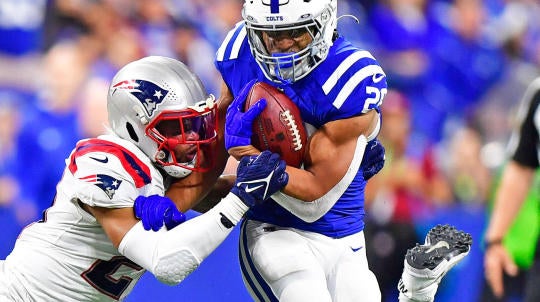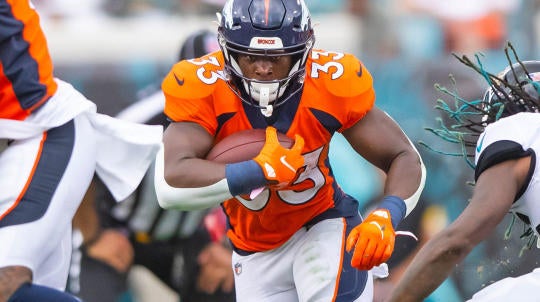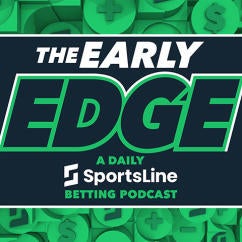| |
 |
| Monday, August 1, 2022 |
| |
And Taylor obviously won't be alone. In ADP, seven of the first 12 players are running backs and 14 of the top 24, too. And history suggests those will be good picks – between 2016 and 2020, running backs picked in the first round had 300-plus PPR points in 12 of 30 seasons, with 12 out of 30 reaching at least 200; 13 out of 23 had 200-plus in the second round, as well. |
This week is all about running backs at the CBS Sports Fantasy Football Draft Prep page, as the entire Fantasy Football Today team will be breaking the position down from every possible angle to make sure you're ready to draft what may be the most important position in Fantasy. And that starts today in the newsletter, as I'm going to take a look at the state of the position entering 2022 and tackle some of the biggest questions facing Fantasy players this season. |
Adam Aizer and I talked about a few of those big questions in Monday's episode of Fantasy Football Today in 5, so check that out for Aizer's takes on the Broncos backfields, Ezekiel Elliott's reported demise, and the rookie running back class. I'll have more in-depth thoughts on all of those topics this week, and we'll wrap it up Friday with an RB cheat sheet with everything you need to know, including our latest rankings. |
| For now, let's get to know the running back position before we dive deeper. You can start with the following links from the FFT team: |
| |
| |
| The state of the running back position |
 |
| So, how does running back look heading into 2022? Interestingly, while it feels like there is a sense among most Fantasy analysts that running back is the deepest position at the top of drafts, only seven running backs are going in the top-12 in ADP on NFC right now, matching with 2019 for the lowest number since 2017. |
| That could actually be seen as a statement on the relative depth of the position, for what it's worth; with seemingly so few impact wide receivers and tight ends available, getting a difference maker like Travis Kelce, Cooper Kupp, Justin Jefferson, or Ja'Marr Chase might actually be a bigger priority, knowing you can wait for the likes of Aaron Jones, Saquon Barkley, Alvin Kamara, Leonard Fournette, or Nick Chubb, all of whom are between the 18th and 24th player taken in NFC drafts on average. |
| Of course, you might look at that list and wonder whether the position is quite as deep as we're making it out to be. Each of those players has some pretty significant question marks, from availability (Kamara, Barkley) to role (Jones, Fournette) to upside (Chubb). Of course, if you don't end up with one of those guys as your No. 1 RB, you're then left with the Cam Akers/James Conner/Breece Hall/Travis Etienne crew, who have massive question marks of their own with their third-round ADPs. |
| |
Those two groups are a good example of why I remain a proponent of the Hero-RB strategy, which mostly just means taking one of the studs in the first two rounds. What spot in the draft you end up with will obviously influence how you attack any strategy, but generally speaking, if I can end up with one of my top-five running backs – any one of the top three tiers here – I'm content to fill out the rest of my positions before I look for my No. 2 and 3 options. |
| Mostly because I'm trying to avoid the RB Dead Zone, one of those Fantasy buzz phrases that I am a true believer in. The idea is that you reach a point in drafts every year where running backs tend to become really bad investments. Historically, that's been around the 13th running back taken, around the third round and especially after. From 2016 through 2020, running backs drafted in the third round got to 300 PPR points 5% of the time and 200-plus 40% of the time; in the fourth and fifth, zero of 35 got to 300-plus points and just 23% even reached 200. |
| That's where you tend to find the reaches at the position, obviously. It's where the young guys with uncertain roles and unproven track records and the mediocre veterans with limited real upside but presumed "safe" roles end up being pushed up to. If you're looking for examples of the Dead Zone RB archetypes, Etienne, J.K. Dobbins, Antonio Gibson, Elijah Mitchell, and A.J. Dillon all fit in the former category, while Ezekiel Elliott, Josh Jacobs, Damien Harris, and Clyde Edwards-Helaire fit the bill for the latter. |
That's not to say you shouldn't draft any of those players; it's not even to say I won't draft any of those players. I even like a few of them – though I'll admit to feeling a bit like Tobias Funke going " But it might work for us …" every time I draft Jacobs or Elliott. But it is to say that, if you're going to make a point of investing in the RB Dead Zone, just know that the odds aren't in your favor. |
| Suppose you're going to skip the elite running backs and the Dead Zone running backs. In that case, that means you're going with a Zero-RB build, which means you need to be looking for a mixture of potential early-season floor plays (I like Rashaad Penny, Chase Edmonds, and Cordarrelle Patterson for that part) and upside picks, like Rachaad White, Kenneth Gainwell, and Tyler Allgeier . The attrition rate at running back is so high – I'd estimate somewhere around 50% of expected running backs in Week 1 aren't in that role by Week 8 most seasons – that you're betting that you can secure high weekly upside at every other position while positioning yourself to chase the inevitable backs who pop up on the waiver wire every year. |
| It's a risky strategy, but the thing to keep in mind is … nearly all running backs are risks. They are inherently injury prone and, because so much of their value is dependent on things out of their control – coaching choices, offensive scheme, the competence of their teammates – they ultimately end up being quite unpredictable. |
| If you're new to Fantasy Football, maybe that's the biggest thing you should take away from this: No matter how strong or weak running back looks, either as a whole or on your team, you should bet on it looking drastically different in the not-so-distant future. |
| |
| Five big questions about running back |
 |
We'll be going deeper on each of these questions and countless others the rest of the week, and the rest of the FFT team will be giving their own answers at some point – make sure you're subscribed to the podcast if you aren't already for some weird reason, as they begin position previews this week. |
| But here are my quick thoughts on five big questions kick off RB preview week: |
| Is Zero-RB or Hero-RB still a viable strategy? |
I just went over it a bit, but absolutely! Zero-RB and Hero-RB (or "modified Zero-RB" or whatever you want to call it) are concepts based on historical trends that have been proven year in and year out. Heath Cummings will be writing about his Zero-RB targets later in the week, but you can check out this piece from last year where he goes over the basics of the strategy in case you aren't familiar, it basically comes down to what I wrote about earlier: Running backs are the ultimate risk. |
| I think the Hero-RB strategy more accurately reflects the reality, because in the first couple of rounds, running backs don't tend to be much riskier than any other position, and they tend to have a bit more upside (especially at the highest end). However, the thing you want to remember is, if you do end up starting a league with, say, Travis Kelce, Mike Evans, and A.J. Brown, you shouldn't feel obligated to turn around a double up on running backs with your next two picks to make up for missing out on the high end. You missed out on the high end, you're not going to make up for it later on. |
I'm not a dogmatic adherent to either Zero- or Hero-RB – I doubled up on Christian McCaffrey and Alvin Kamara in a recent draft that I wrote about last week – but I'm a firm believer in the principles behind them. Avoiding the RB Dead Zone is one of the surest ways you can secure an edge on your competition. It isn't guaranteed to work out, but the odds are in your favor. |
| Should anyone but Jonathan Taylor be the No. 1 RB? |
| Yes, Christian McCaffrey! Next question! |
Okay, I recognize I'm in the minority on this one. Neither Jamey, Dave, nor Heath agrees with me, and only 21 out of 144 experts on FantasyPros.com have McCaffrey as the No. 1 RB. There are dozens of us – dozens! |
| But I think McCaffrey is the highest upside player in Fantasy, and while his injury history is obviously concerning if I'm starting from the assumption that all running backs have a relatively high probability of getting hurt, I'm just not going to put much value into "safety." Is McCaffrey more likely than Taylor get hurt? Yeah, probably. But it is by no means a certainty, and McCaffrey is practically a lock for 24-plus PPR points when he's healthy. I don't pass that up. |
| Is Javonte Williams ready to be The Guy? |
| The running joke on FFT last season was that every week was Javonte Williams Week. There was a good month-long stretch where one analyst or another predicted each week would be the week the Broncos finally turned things over to WIlliams ahead of Melvin Gordon, and they were never really right. There was the one game where Gordon was out and Williams was a superstar, racking up 178 yards, six catches, and a touchdown in Week 13, but Gordon returned the following week, started each of the final five games, and actually had more carries than Williams in that stretch. |
| Of course, we've got a new coaching staff in Denver, with Nathaniel Hackett taking over as head coach after spending three years as the … Packers offensive coordinator. The Packers, who famously involve multiple running backs every week, much to Fantasy players' eternal consternation. |
| That's not to say Williams is ticketed for a split role again, and even if he is, I suspect it'll be more like a 60-40 split. But, it is to say that his RB9/15.4 overall ADP is inviting an awful lot of risk. There's upside, too, to be sure, enough that I have taken Williams as my No. 1, but I'm prepared to be let down. |
| Will any of the rookies be a must-start for Fantasy? |
| |
| Well, I've got Hall ranked down at RB22, so I guess I'm going against history. The Jets ranked 22nd in PPR points by running backs last season, and while 64% of their overall passes were thrown by Zach Wilson, just 52% of the passes thrown to running backs came from Wilson. We're hoping the Jets offense will take a step forward this season, but that is by no means a guarantee, and at least from what we saw last season, there's a chance Wilson significantly limits the upside of the running backs in this offense by not looking for them in the passing game. |
| Maybe that changes with Hall. Or, maybe he's such a dynamic playmaker that it just doesn't matter; it doesn't matter that Derrick Henry and Jonathan Taylor don't catch passes. Hall is skilled enough to be a factor in the passing game, for what it's worth, but it's also unfair to expect him to be as good as either Taylor or Henry, or anywhere close. He doesn't have to be to be a must-start, but I just don't love the circumstances he landed in and I think he'll be a frustrating RB2 who may share touches on an offense that insisted on splitting things up last season, too. |
| Which backups have the most upside? |
| Again, we'll have a deeper dive on this later in the week from Dave Richard, but here's a quick list of my favorite running backs with upside to target after the 100th pick in ADP: Rhamondre Stevenson, Isaiah Spiller, Alexander Mattison (obviously), Rachaad White, James Robinson, Kenneth Gainwell, Tyrion Davis-Price, Chris Evans, Trey Sermon, Tyler Badie. |
| |
 | |  | | | | | ✔Scores & Highlights ✔Fantasy and Betting Advice ✔Interviews with Top Athletes CBS Sports HQ has you covered. Stream anywhere, anytime, on any device. Watch Now
| | Looking for the best picks against the spread, sharp action on the total and props you can take to the ticket window? Join The Coach, Jonathan Coachman, on the Early Edge as he speaks with the best handicappers to preview every day’s biggest games. Listen Now
|
|
| |
| |
